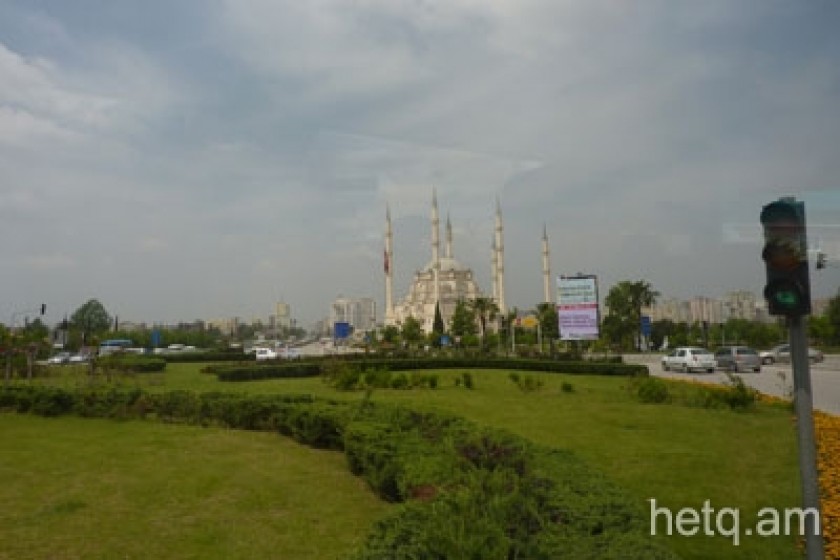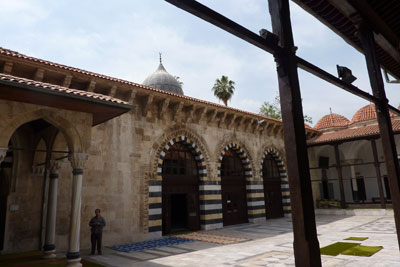
Adana Flourishes Again; This Time Without Armenians
Let me start off by saying that I will be reporting off and on from Turkey for the next few days. I am with a group of reporters from Armenia that will eventually wind its way back to Armenia by air and ground transport.
We arrived in the city of Adana today, our first stop after Istanbul. Our escort, Ferzan, took us to see some of the sites of Adana, First on the list was the Ulu Cami (The Grand Mosque) complex within a high wall in the old town.
It opened for religious services in 1541 and severely damaged in the 1998 earthquake. It was restored and opened its doors in 2004.
 Now for some history. Adana was captured by forces of the Armenian Kingdom of Cilicia in 1132. It was taken by Byzantine forces in 1137 but recapture by Armenians around 1170. After a terrible earthquake in 1268, Adana was rebuilt and remained a part of Armenian Cilicia until 1359 when the city was ceded by Constantine III to the Mamluk Sultan of Egypt in a peace deal.
Now for some history. Adana was captured by forces of the Armenian Kingdom of Cilicia in 1132. It was taken by Byzantine forces in 1137 but recapture by Armenians around 1170. After a terrible earthquake in 1268, Adana was rebuilt and remained a part of Armenian Cilicia until 1359 when the city was ceded by Constantine III to the Mamluk Sultan of Egypt in a peace deal.
The Mamluks' capture of the city allowed many Turkish families to settle in it. The Ramazanoğlu family, one of the Turkish families brought by the Mamluks, ruled Adana until the Ottomans captured the city.
Our next stop was the Taskopru (Stone Bridge) spanning the Seyhan River. It’s also known as the Justinian Bridge. The inscription indicates that the bridge was built during Roman Empire by the architect Auxentius.  The reason that the name of Justinian I is mentioned relating to the construction period on the inscription is probably the extensive restoration of the bridge done by him later.
The reason that the name of Justinian I is mentioned relating to the construction period on the inscription is probably the extensive restoration of the bridge done by him later.
Then we were taken to the Sabanci Merkez Mosque. Though not being historical, is the most visited mosque in Adana, as it is one of the largest mosques in the Middle East. The mosque was opened to service in 1998 to a capacity of 28,500 prayers.
We then asked our Turkish organizers to show us something Armenian that might have survived in Adana. They said there was nothing to show.
Steps away from the old Roman bridge is the historical neighborhood of Tepebag, a well to do Armenian district back in the Ottoman era that reflects the Armenian architecture of the city with fine houses, gardens and stone-made schools.
Ferzan noted that there might be some Armenians left in the city but they keep the fact to themselves.
Figures as to these Crypto-Armenians remaining in Adana vary as widely as those figures for Turkey as a whole. Some say there might be up to 2,000 such families in Adana today. There is also a good number of descendents of Armenian children who were given to Muslim families to be fostered in 1915, either by their Armenian parents or by the Ottoman officials. Armenians and Greeks were to constitute half of the population of Adana before 1915.
Armenians were well represented in local manufacturing and trade. They owned paint cotton, cloth, beer and other factories and operated gold, silver, leather and ceramic artisan shops. Armenians also had their own cultural centers, hospitals, theaters and schools. In the 19th century, the city had four churches; 2 Armenian, 1 Greek and 1 Latin.
I wonder if our Turkish escorts even are aware of the historical Armenian presence in Adana and the surrounding countryside; if they were ever taught how the Armenian community was evicted and destroyed in succeeding waves – 1909, 1915 and 1922-23
I would be amiss if I didn’t bring up the fact that Adana is home to a community of around two-thousand British and Americans serving to the Incirlik NATO Air Base.
Recently Armenian Genocide survivors are preparing a legal suit claiming that the base is built on land once owned by local Armenians. Just think of it, a NATO base which helps defend Turkish interests in the region just might have been built on lands confiscated from Armenians killed in 1915 when all of the estimated 20,000 Armenians in the city alone were rounded up and marched out into the Syrian Desert.
Today, Adana is Turkey’s fifth largest city with a population of 1.5 million and noted for its agriculture and a rapidly developing economic base. The major ethnic groups are Turks, Arabs and Kurds, with the latter now comprising almost a third of the population due to massive migration in the 1990s.
We had a chance to meet with the local Association of Young Businessmen and its director Hakan Celik. Last year, Adana boasted exports of around $1billion.
 Celik noted that with a regional population of close to 5 million, Adana’s economy is set to take off even though it still lags behind Istanbul, Izmir and a few other cities.
Celik noted that with a regional population of close to 5 million, Adana’s economy is set to take off even though it still lags behind Istanbul, Izmir and a few other cities.
The young entrepreneur said his Turkish colleagues would like to collaborate with their Armenian counterparts and they regard Armenia as one of their neighbors.
"We see that the Turkish and Armenian governments have their views on history, but we believe that the more relations on a personal level develop the more business ties will develop and we can thus reject those views," Celik noted.
The Turkish businessmen confessed that they knew little about the economic environment in Armenia and whether or not entrepreneurs in Armenian were ready to work with Turks.
Celik added that if the Armenians could "overcome" their preconceived notions about Turks, cooperation in a number of sectors was possible and that this would assist in normalizing relations between the two nations as well.
 Videos
Videos Photos
Photos
Comments (9)
Write a comment